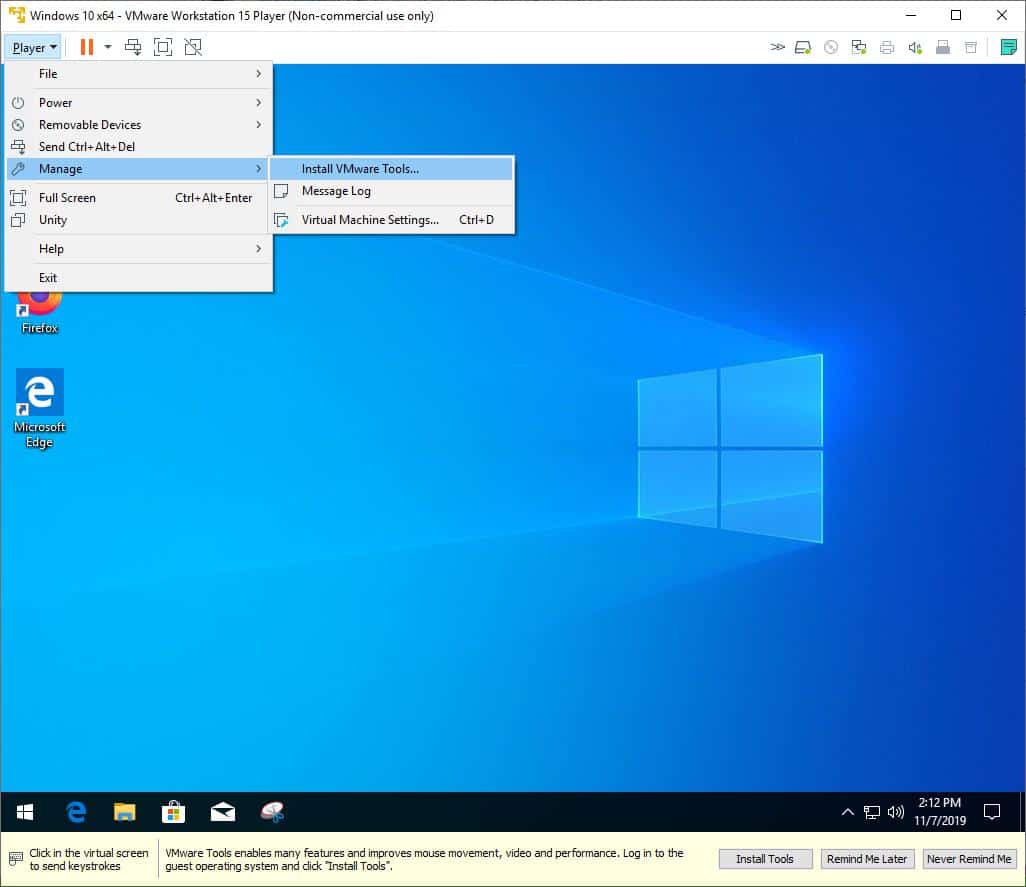
- #Install windows 10 in vmware on mac how to
- #Install windows 10 in vmware on mac mac os x
- #Install windows 10 in vmware on mac install
- #Install windows 10 in vmware on mac drivers
- #Install windows 10 in vmware on mac update
To switch between Windows and macOS, simply restart your computer and then press and hold the Option key during startup.
#Install windows 10 in vmware on mac drivers
Follow the instructions to set up drivers and everything else necessary to dual boot Windows on a Mac computer.
#Install windows 10 in vmware on mac install


#Install windows 10 in vmware on mac how to
You also need 64 GB or more free storage space on your Mac startup disk, a Windows 10 disk image (see the How to Get Windows for Mac chapter), and a USB flash drive with a storage capacity of 16 GB or more (unless your Mac doesn’t need a flash drive to install Windows). This list DOESN’T include Macs with Apple’s M1 chip because Boot Camp only works on Intel-based Macs.

Rm -rf /Volumes/Catalina/System/Library/PrelinkedKernels/prelinkedkernel (replacing "Catalina" with whatever you named your hard drive earlier): cp -rf /Volumes/CatalinaAMD/System/Library/Kernels/kernel /Volumes/Catalina/System/Library/Kernels/ Reboot the VM back into the BIOS, select the installer and open Terminal once again. If the VM restarts and you get a ‘CPU is disabled’ error, close the error window, attempt to close the VM window, select ‘Power Off’ and reopen VMware. The Catalina installation process will be continued: Volumes/CatalinaAMD/System/Library/PrelinkedKernels/prelinkedkernel to the Hark Disk Catalina /Volumes/Catalina/macOS Install Data/Locked Files/Boot Files/Īfter execute the command, restart the VM again. With that command, we coppy all the prelinkedkenel under the installation source CatalinaAMD Type this command in Terminal (replacing "Catalina" with whatever you named your hard drive earlier): cp -rf /Volumes/CatalinaAMD/System/Library/PrelinkedKernels/prelinkedkernel /Volumes/Catalina/"macOS Install Data"/"Locked Files"/"Boot Files"/ Once the installer has booted, click on "Utilities" in the Finder bar and select "Terminal". This is our Catalina installer that we are booting. Power off or reset the virtual machine.Įdit the vmx file by adding the following line to the bottom of the vmx file: bios.bootDelay = "2000"īack to the BIOS, Select "EFI VMware Virtual SATA Hard Drive (2.0)" and press enter. The CPU has been disabled by the guest operating system. Select the hard drive that we erased earlier with Disk Utility and press "Install". When the installer opens, press "Continue".Īgree to the terms and conditions. Select "Reinstall macOS" and press "Continue".

Change "Format" to APFS and press "Erase". Select "VMware Virtual SATA Hard Drive Media" under "Internal" hard drive. Select "Disk Utility" and press "Continue".
#Install windows 10 in vmware on mac update
#Install windows 10 in vmware on mac mac os x
Open VMWare, create a new VM, Select Apple Mac OS X under Guest operating system and choose "macOS 10.15" under Version.Run the Unlocker by running the win-install.cmd with Administrator right.Install the VMWare as your way, either Player or Workstation will be fine.VMware Player /Workstation Pro 15 or higher.CPU also needs to support the SSE4.1 and AMD-V.VMware’s graphics acceleration not being compatible with macOS, you will not have any graphics acceleration in your virtual machine. USB-A to RJ45 ethernet adapter and USB-C to Audio Jack dongleĪnd this guide is a Personal experiment about how to setup the Fresh MacOS on the Laptop AMD with Windows 10 host.USB 3.2 Type A, USB 3.2 Type C and Micro SD card reader.AMD Ryzen 7 4700U Processor (8M Cache, up to 4.1 GHz).Yeah, it’s AMD Ryzen 7 4700U with Radeon Graphics Vega 7. I had bought a new laptop on Dec 2020 to replace the old one – Sony VAIO E VPCEG23 11 years old, It’s ASUS Zenbook UM425IA from, but wait, the AMD laptop. Don’t want to try these complexity steps? Just Run my pre-made macos BigSur VMDK.


 0 kommentar(er)
0 kommentar(er)
